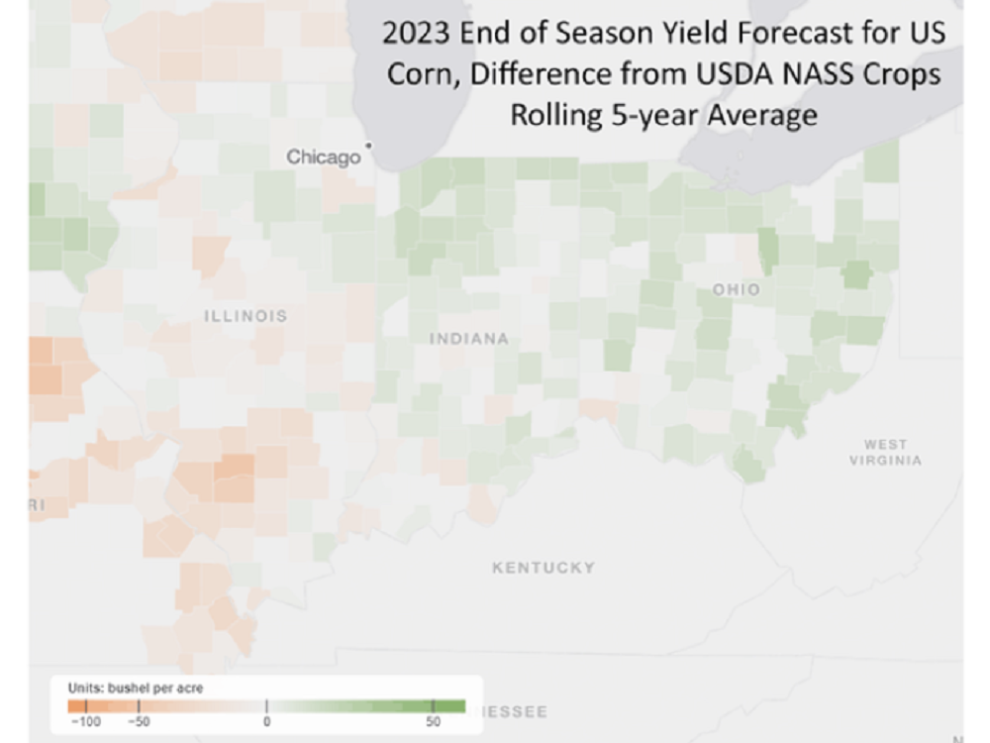Illinois’ Resurgence From Drought Steals Spotlight, but Indiana, Ohio Crops Shine
May and June’s flash drought focused its intensity on Illinois like the sun through a magnifying glass. July rains brought a robust recovery where they fell, and left fields gasping where they didn’t.
Illinois’ comeback corn crop is no record-setter, but it’s respectable. The DTN Digital Yield Tour, powered by Gro Intelligence, finds a statewide average corn yield of 197.3 bushels per acre (bpa).
“Ohio and Indiana yields have been much more stable,” Gro Intelligence Senior Analyst Jon Haines said, referring to how Gro’s corn and soybean yield models reacted to early season drought. “Illinois’ story is all about its resurgence with those heavy rains and its ability to recover.”
Gro’s yield models anticipate corn yields in Ohio and Indiana will outperform last year but fall short of 2021’s records. On Aug. 8, 2023, Gro’s models had Indiana’s average yield at 193.7 bpa and Ohio’s at 190.7 bpa. They’ve also varied less throughout the growing season.
On soybeans, Gro’s yield models estimate Illinois will average 60.2 bpa; Indiana, 58.9 bpa; and Ohio, 58.7 bpa, which would beat the current record by 1.7 bpa if realized.
“One of the biggest concerns early in the year was that this was a drought threat that was hitting the biggest-producing states and caught Illinois in that net, although it turned out to be for a short time,” DTN Lead Analyst Todd Hultman said. “Gro’s showing that Indiana and Ohio stayed fairly protected from that, as the Eastern Corn Belt often is more protected from the extreme temperatures and drought threats that come and go. Illinois really took the worst of it and came out smelling pretty good.”
The DTN Digital Yield Tour, now in its sixth year, takes an in-depth look at how this year’s corn and soybean crops are progressing using Gro’s yield models. The models form county-level yield estimates every day in main corn and soybean growing states using satellite imagery, rainfall data, temperature maps and a wide range of other data.
Details on each of the Eastern Corn Belt states can be found below.
This is the second day of the Digital Yield Tour. On Monday, we looked at national corn and soybean yields. Read more here: https://www.dtnpf.com/….
On Wednesday, our coverage moves to Nebraska, Iowa and Wisconsin.
For your convenience, all the stories, videos and images from the tour can be found at https://spotlights.dtnpf.com/….
WEATHER COMMENTS
Lingering cold temperatures slowed planting in Indiana and Ohio this spring, but Illinois had better weather and a rapid start. “So, when flash drought developed in May and June across all of Illinois and Indiana and most of Ohio, it was especially rough on the crop in Illinois,” DTN Ag Meteorologist John Baranick said. “Subsoil moisture was essentially used up early in the season. There are many places in Illinois and Indiana that saw little or no rain throughout the month of June, but that all changed rather quickly.”
On June 29, a derecho — a type of long-lived, damaging thunderstorm — pushed across the border of Iowa and Missouri, through central Illinois and into Indiana. “While the blown-over corn was not ideal, the rainfall from that event was,” he said.
Streaks of showers and thunderstorms in July became more consistent in August, hitting most places fairly evenly, although there are exceptions, Baranick said.
“It has been a rapid turnaround in conditions across these three states, especially in Illinois where the crop just looked so bad for a while there in June,” he said. “These states are still largely living off the rain they’re getting, so as long as the pattern stays active, they could trend positive, especially for soybeans.”
He said the forecast through next week favors mild and showery conditions that should help crops fill out nicely, but cautions that the pattern could change in late August and September.
ILLINOIS
Corn: 197.3 bpa
— USDA five-year average: 199.6 bpa
— High: Warren County, 217.8 bpa
— Low: Perry County, 137.8 bpa
Soybeans: 60.2 bpa
— USDA five-year average: 61.1 bpa
— High: Macon County, 69.7 bpa
— Low: Johnson County, 45.2 bpa
Gro Comments: Gro Intelligence Senior Analyst Mintak Joo said Gro’s Illinois corn yield estimate has shifted drastically throughout the season. The Digital Yield Tour estimate of 197.3 bpa is up 40% from the model’s lowest estimate this season.
“I think it was a tale of two months,” he said. “June was awful. July was exceptional, especially in terms of rainfall.”
The highest-yielding pocket on Gro’s maps is west-central Illinois, where yield estimates in Logan, Carrol and Warren counties hover around 217 bpa. The worst spots are in the state’s southwest.
For soybeans, it’s east-central Illinois that shines with many counties boasting averages above 65 bpa.
Farmer Comments: Some of Jamin Ringger’s McClean County, Illinois, farm went 55 days without rain in May and June.
“Things have turned around tremendously. The corn crop is looking a lot better than what it was. The bean crop has gotten better. It’s still not going to be a record bean crop by any means,” he told DTN on a visit to his farm in late July.
On Aug. 8, Gro Intelligence’s yield models showed county-average yields in his area trending between 205 and 210 bushels per acre.
“In June, we were thinking it was going to be a crop insurance year, that it was going to be well under APH (actual production history), and now it’s looking like we’re getting to be well above APH. It just kind of depends on how August plays out, if we get a few more timely rains and how hot it is.”
Ringger expects his corn ears to fill kernels to the tip thanks to cooler, wetter weather during pollination in the first week of July.
His soybeans need some rain in August. “Man, we need some sunshine, too,” Ringger said, adding that the smoke of Canadian wildfires lingered over his fields much longer than he would have preferred. “Soybeans just need sunlight and some late rains,” he said.
— DTN visited Ringger’s farm in late July. Learn more here: https://www.dtnpf.com/….
— DTN, in partnership with Farmers’ Independent Research in Seed Technology, has placed a camera in eight FIRST test plots, adding a new image to the video each day. One of the cameras is on Ringger’s farm. Watch it here: https://www.dtnpf.com/….
— Other FIRST cameras are available for:
— Chadwick, Illinois: https://www.dtnpf.com/…
— Effingham, Illinois: https://www.dtnpf.com/…
INDIANA
Corn: 193.7 bpa
— USDA five-year average: 186 bpa
— High: Clinton County, 215.6 bpa
— Low: Dearborn County, 161.7 bpa
Soybeans: 58.9 bpa
— USDA five-year average: 57 bpa
— High: Clinton County, 68.7 bpa
— Low: Dearborn County, 47.3 bpa
Gro Comments: Indiana’s corn and soybean yields have the potential to outperform last year, coming in about 2% higher than last year’s final estimates and above their five-year averages. Gro Intelligence Senior Analyst Will Osnato said drought conditions weren’t as extreme, partially because temperatures weren’t as high above normal as they were in Illinois.
For corn, Gro’s models show a garden spot northwest of Indianapolis, with estimates for Montgomery, Clinton and Tipton counties pushing the upper limits of 214 to 215 bpa.
The best bean potential is also clustered in this area, with some county estimates climbing above 65 bpa.
Farmer Comments: Planting on Guy Schafer’s Pendleton, Indiana, was seriously delayed this year by cold temperatures and wet fields. The no-till farm didn’t start planting corn until May 10, much later than some of the conventional farms in the area.
“Our soils took longer to warm up and dry out, but I think that turned into a benefit once the dry June hit. We were able to hold onto that moisture longer in the soil. We never really saw a soil moisture deficit on our farms,” he told DTN from his farm in late July.
The crop pollinated at the end of July, and Schafer said some of his later-planted fields seem to have caught better rains and show the most potential, an unusual reversal from typical patterns.
“I don’t think we’re going to have a yield-breaking year by any means,” he said. He anticipates yields about average, which for the waxy corn he grows, is in the 170- to 180-bushel-per-acre range.
Schafer is pleased with the soybean crop’s potential. He said there are very few tall bean fields to be seen, but the ones he’s walked have had a lot of pods forming closely together.
— DTN visited Schafer’s farm in late July. You can find more of his perspective here: https://www.dtnpf.com/….
— View FIRST’s plot camera in Wabash, Indiana, here: https://www.dtnpf.com/….
OHIO
Corn: 190.7 bpa
— USDA five-year average: 180.4 bpa
— High: Clinton County, 202.4 bpa
— Low: Belmont County, 143.3 bpa
Soybeans: 58.7 bpa
— USDA five-year average: 54.5 bpa
— High: Preble County, 63.6 bpa
— Low: Monroe County, 43.7 bpa
Gro’s Comments: Of the states in the Eastern Corn Belt, Ohio shines. Haines said most counties have been trending above the five-year-average corn yield all summer long. “Ohio’s doing pretty well, though, relative to normal,” he said.
Generally, corn yields north and west of Interstate 71 are above 190 bpa, topping out at 202.4 bpa in Clinton County and 200.7 bpa in Fulton County.
Ohio could set a new soybean yield record if Gro’s estimate of 58.7 bpa comes true. The current record, 57 bpa, was set in 2021. The strongest yield potential is found in a triangle between Columbus, Dayton and Lima.
Farmer Comments: On Steve Reinhard’s farm in north-central Ohio, the corn looks to make an average to above-average crop. What got planted during an April warm spell looks the best. Cool and dry conditions slowed down plant growth early in the season, and while June was dry, it wasn’t as hot as other areas of the Corn Belt.
“Our soybeans have had trouble growing past the disease pressure,” he said, adding that cool weather stalled growth so long that seed treatments weren’t as effective as normal. The rain and warmer temperatures created a breeding ground for phytophthora, charcoal rot and some other diseases.
“Maybe as good as our corn is our soybeans are maybe going to be average to maybe a little bit below,” he said.
Katie Dehlinger can be reached at katie.dehlinger@dtn.com
Follow her on Twitter at @KatieD_DTN
Source : dtnpf.com






































